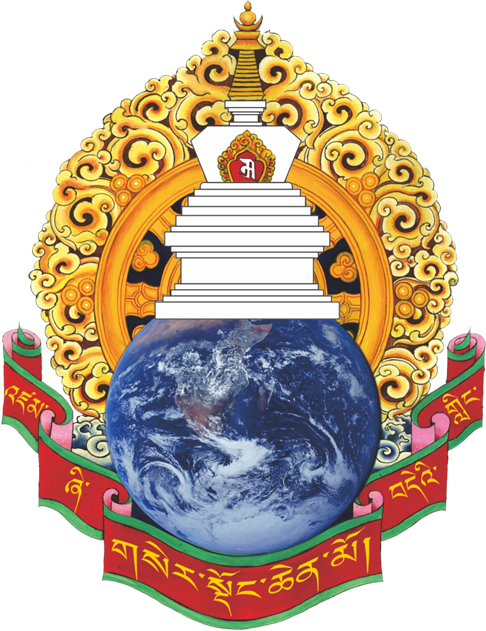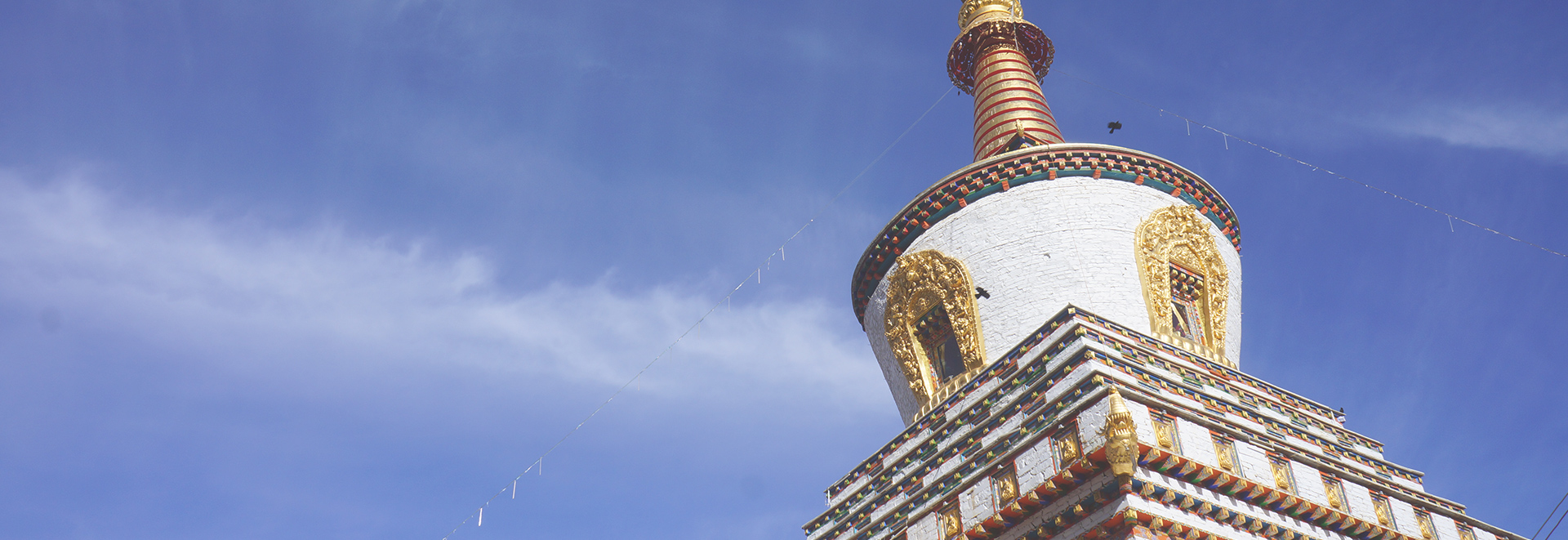Longchen Nyingtig Lineage
LINEAGE

NYOSHÜL Lungtok Tenpe Nyima was one of the greatest meditation masters of Dzogpa Chenpo in the Longchen Nyingthig lineage. He was the greatest realized disciple of Paltrül Rinpoche. There is a saying, “If there is no Lungtok, Paltrül is childless.”
He was known as the tülku of Shāntarakṣhita, Kong-nyon Bepe Naljor, and Jewön Küntröl Namgyal. He was born in the Nyoshül tribe of the Mukpo Dong lineage as the son of Chösung Tadrin.
He studied with Gyalse Zhenphen Thaye, Khenchen Pema Dorje, the fourth Dzogchen Rinpoche, and later with Khyentse Wangpo. He was ordained as a monk by Gyalse Zhenphen Thaye, who named him Lungtok Tenpe Nyima.
Lungtok’s root teacher was Paltrül Rinpoche. Living with Paltrül for twenty-eight years without separation, he received the transmissions of various teachings and especially Nyingthig teachings of Longchen Rabjam and Jigme Lingpa. He received the instructions of Trekchö teachings, which introduced him to the primordial purity that is present as the ultimate nature of all phenomenal existence. He received the instructions of Thögal teachings, which introduced him to the luminous appearances as the three Buddha bodies. He stayed about ten years around the seats of Dodrupchen in Ser and Do valleys with Paltrül Rinpoche.
At the Ari forest in the Do Valley, a few miles from the present Dodrupchen Monastery, Lungtok and his teacher Paltrül stayed alone together for six months. A small bag full of tsampa as food, the clothes they were wearing, and a couple of books were the only things they possessed. At midday they would get together and eat a little tsampa. Then they would tie the tsampa bag to a tree and leave it till the next day. After that Paltrül would give teachings on a couple of verses of the Bodhicharyāvatāra to Lungtok. Soon, many disciples arrived at Ari Forest, and Paltrül started to teach Ngalso Korsum and Yönten Dzö and other teachings. Paltrül Rinpoche would give a teaching, and then the disciple would meditate on it in the forest for days. First they had a little tsampa to eat every day, but soon their tsampa ran out. Then they collected food given to dogs by nomads or left behind, and they lived on that for a while. They didn’t want to go around nomad camps to beg for food, but were happy to live with what was left unwanted.
At Ari forest, one day Paltrül asked Lungtok, “Do you remember your mother?” Lungtok said, “Not much, sir.” Paltrül said, “It is because you haven’t meditated on compassion. Now go into those willow trees and meditate on ‘recognizing motherhood’ and ‘remembrance of mother’s kindness’ for seven days.” Lungtok meditated as Paltrül had instructed, and the bodhichitta of lovingkindness and compassion naturally developed in him without any need of further efforts.
At Ari forest, after Paltrül’s teachings, Longtok meditated on the meanings of Relaxing in the Illusory Nature (Gyuma Ngalso) by Longchen Rabjam. His concepts of grasping at truly existing entities collapsed, and all phenomenal existents arose as unreal like illusions. Later Khenpo Ngachung asked him, “Is it a realization?” He answered, “No, but a good experience” (Nyams).
With Paltrül, Lungtok left Golok for Dzogchen Monastery. Lungtok did a three-year retreat at Kangtrö near Dzogchen Monastery for the longevity of the fourth Dzogchen Rinpoche. He didn’t have much food to eat. He had no clothing except his robes. He used a flat stone as his cushion to sit on for his three-year retreat.
Then Lungtok stayed with Paltrül at Nakchung hermitage near Dzogchen Monastery. Every day at dusk, Paltrül would do a meditation session on the training of Namkha Sumtruk, stretched out on his back on a new woolen carpet on a piece of grassy field the size of himself. One evening, while Paltrül was lying there as usual, he asked Lungtok, “Lungche [Dear Lung]! Did you say that you do not know the true nature of the mind?” Lungtok answered, “Yes, sir, I don’t.” Paltrül said, “Oh, there is nothing not to know. Come here.” So Lungtok went to him. Paltrül said, “Lie down, as I am lying, and look at the sky.” As Lungtok did so, the conversation went on as follows:
“Do you see the stars in the sky?”
“Yes.”
“Do you hear the dogs barking in Dzogchen Monastery [at a far distance]?”
“Yes.”
“Well, that is the meditation.”
At that moment, Lungtok attained confidence in the realization in itself. He had been liberated from the conceptual fetters of “it is” or “it is not.” He had realized the primordial wisdom, the naked union of emptiness and intrinsic awareness, the Buddha Mind.
Lungtok and his esteemed Dharma brothers, Tendzin Norbu, Khenpo Könchok Özer, Minyak Künzang Sönam, and Naktha Tülku, requested Paltrül to allow them to remain as wandering hermits for the rest of their lives. But Paltrül made Könchok Özer a Khenpo of Dzogchen Monastery; he told Tendzin Norbu to teach at Gemang Monastery and the other three to return to their own home regions and maintain hermitages. So Lungtok came back to his home region and stayed at many hermitages, but mainly at a hermitage named Jönpa Lung.
At Shuku Shar hermitage, Lungtok meditated on Bodhicharyāvatāra for ten years and on Ngalso Korsum for three years. Later, he jokingly would say, “For thirteen years by projecting and withdrawing thoughts, I tried to discipline my thoughts so they wouldn’t be increased. If I had meditated on Dzogpa Chenpo from the beginning, I could have realized a good view and meditation by now.”
In 1883, when he was at Gyaduk hermitage, a five-year-old boy was brought to see him by his father. That boy was the future Khenpo Ngawang Palzang (1879–1941), his main lineage-holder.
Around 1895, Lungtok moved to Pema Ritho and established an encampment of hermits, and Ngawang Palzang formally became his disciple by studying ngöndro and other teachings with many others.
Lungtok said, “I haven’t done anything against Paltrül Rinpoche’s advice, except one thing, which is that he told me not to teach Dzogpa Chenpo before the age of fifty. Then, if I could, I should teach it. But before the age of fifty I had to teach a little to Önpo Tendzin Norbu, as he insisted. So my samaya with my teacher is an unbroken golden chain.’’
Later, he would tell his disciples, ‘‘If you meditate properly, the best meditators will make daily progress, the mediocre meditators will make monthly progress, and the lesser meditators will make yearly progress. For meditation the important thing is to know the crucial skills [gNad] of meditation. Even if you meditate, if there is no progress, it is a sign that you lack the understanding of the crucial skills of meditation.’’
Throughout his life he shared the teachings of Paltrül with all who came to him, and especially after the age of fifty he gave Dzogpa Chenpo teachings. However, like Paltrül Rinpoche, he hardly gave any transmissions of empowerment except to Sershül Khenpo Ngawang and Anye Khenpo Tamchö of Dodrupchen Monastery, Lama Ngawang Tendzin, Lama Dorli, Khenpo Ngawang Palzang, and a kama empowerment at Khangtsik Gar.
He wrote a detailed instruction on Trekchö meditation for Nyakla Rangrik, who was then in Central Tibet, and he asked him to burn it after reading it. Nyakla Rangrik did burn it as his teacher told him to do, but the messenger saw it on the way and copied it before it reached Nyakla Rangrik. Many of the amazing writings of Khenpo Ngawang Palzang are also the very words of Nyoshül Lungtok, which originally came from Paltrül Rinpoche.
At the age of seventy-two, Nyoshül Lungtok died on the twenty-fifth of the fifth month of the Metal Ox year of the fifteenth Rabjung (1901). Rainbow lights arched overhead, there was a gentle rain of flowers, and the sound of sweet music was heard. After the cremation, ringsels appeared from the ashes as signs of his attainment and as objects of reverence for his disciples.
His reincarnation was Shedrup Tenpe Nyima (1920–?).
*Above Contents from Masters of Meditation and Miracles: Lives of the Great Buddhist Masters of India and Tibet by Tulku Thondup (1999).


